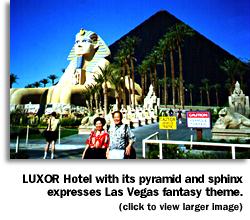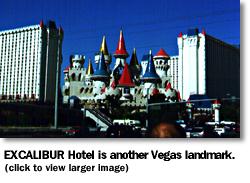
UB sociologist links theming of America to decline of cities
Book explores origins of themed spaces
By SUE WUETCHER
News Services Associate Director
From Walt Disney World to Las Vegas to Planet Hollywood to the local
mall, America is obsessed with themed environments.
 Whether city dweller or suburbanite, these environments increasingly
characterize our daily lives. We eat in the franchised world of fast
food outlets or in theme restaurants, shop in "galleria"-style malls and
vacation at theme parks and attractions.
Whether city dweller or suburbanite, these environments increasingly
characterize our daily lives. We eat in the franchised world of fast
food outlets or in theme restaurants, shop in "galleria"-style malls and
vacation at theme parks and attractions.
This preoccupation with themed environments is due in large part
because these spaces provide the type of pedestrian urban experience
that in the past was found in cities, a UB sociologist maintains.
In his new book, "The Theming of America: Dreams, Visions and
Commercial Spaces" (Westview Press, 1997), Mark Gottdiener, professor
and chair of the Department of Sociology at UB, contends that these
themed environments are selling an experience that for many is lacking
due to the decline of cities, and reflects the increasing competition
among commercial spaces for consumer dollars.
 The book is the first to explore comprehensively the origins, nature
and future of themed spaces.
The book is the first to explore comprehensively the origins, nature
and future of themed spaces.
"Airports, malls, theme parks, casinos all offer the same kind of
experience being a pedestrian, a walker in an urban milieu with
others
in a crowd" that was once freely available in the downtown
sections of
most American cities, Gottdiener says.
But as popular as themed environments have become, they never will
take the place of a bustling urban center, he adds.
"Our themed environments are only limited substitutes for the kind
of rich public spaces that are nurtured in a healthy society with open
cities and a strong public sphere of action," he writes.
The book also raises concerns "about the way in which the needs of
consumption now dominate society and how they negatively affect our
culture," he says.
He offers several theories to explain why Americans have such a
strong need for themed environments:
Commercial establishments need a theme to differentiate
themselves
in an increasingly competitive business environment. Although the
products that are being sold such as food and gambling are
essentially
the same, each restaurant or casino must have a theme to attract
customers, he says.
Environments must entertain, as well as sell merchandise.
Walt
Disney pioneered the concept during the 1950s when he built Disneyland,
and that park has provided the inspiration for the multitude of others
to follow, Gottdiener says, adding that it also has influenced malls,
such as the Mall of America outside Minneapolis, and museums such as the
Rock and Roll Hall of Fame in Cleveland.
"The Disney vision has had a great effect on the construction of
tourist spaces all over the globe," he says.
People find thematic environments entertaining and
enjoyable. "Las
Vegas and Disney World are the world's top tourist attractions," he
says.
In the book, Gottdiener provides historical context for this
present-day obsession.
In the earliest civilizations, everyday life was "over endowed" with
symbols and themes, most of which were derived from religious and
cosmological ideas, he says. This use of symbolism progressed to a
period in early industrial society when the social use of themes in the
environment was discouraged, he says. Later, the modernism movement
minimized the use of symbols, he adds.
But the extensive use of themes crept back into society during the
1960s with the development of consumerist values and their associated
social institutions, such as advertising, mass marketing and the rise of
the mass media, he says.
While the book examines the use of themes and symbols principally in
commercial spaces, it also looks at museums, airports and educational
and monumental architecture.
Gottdiener offers case studies of themed environments of everyday
life, including restaurants, malls and even airports such as those in
Pittsburgh and Denver, whose concourses have become mini shopping malls.
He also devotes a chapter to the Las Vegas casino and theme parks,
themed environments that "depart from the everyday." As opposed to malls
or restaurants, these spaces were constructed principally to entertain,
with merchandising as a secondary function.
Las Vegas, he writes, "is an entire metropolitan area that is quite
literally themed" and whose function is "the seduction of the consumer."
Individually, casinos possess separate themes "that reflect some
desirable fantasy aspect of American culture," he writes.
Caesars Palace Hotel and Casino, for example, is designed as an
immense Roman villa. The Mirage Hotel and Casino stands as a
"tropical paradise," while the MGM Grand-the largest casino-hotel in the
world-elaborates the theme of Hollywood glamour and movie memorabilia.
In examining theme parks, Gottdiener provides two examples:
Disneyland, the granddaddy of all theme parks, and Dollywood. Dollywood
is proof that the theme-park environment, as perfected by Disney, can be
replicated in any setting-in this case Pigeon Forge, Tenn., he says.
The book also discusses cultural experiences that are not commercial
enterprises, but have nonetheless become themed environments. Gottdiener
calls the Vietnam War Memorial in Washington, D.C.-the first successful
"built environment that represents the unrepresentable." The concept has
been copied in other memorials, such as the memorial to commemorate the
Battle of Okinawa, and museums such as the Holocaust Museum in
Washington, he says.
A UB faculty member since 1994, Gottdiener is an internationally
known authority on urban and cultural studies. "The Theming of America"
is his 10th book. He currently is conducting research for a book about
Las Vegas.
PHOTOS BY MARK GOTTDIENER
![[Current Issue]](http://www.buffalo.edu/reporter/icons/Goto_Current.gif)
![[
Table of Contents ]](http://www.buffalo.edu/reporter/icons/TOC.gif)
![[
Search Reporter ]]( http://www.buffalo.edu/reporter/icons/Newspaper.gif)
![[Talk to
Reporter]](
http://www.buffalo.edu/reporter/icons/Phone.gif)
 Whether city dweller or suburbanite, these environments increasingly
characterize our daily lives. We eat in the franchised world of fast
food outlets or in theme restaurants, shop in "galleria"-style malls and
vacation at theme parks and attractions.
Whether city dweller or suburbanite, these environments increasingly
characterize our daily lives. We eat in the franchised world of fast
food outlets or in theme restaurants, shop in "galleria"-style malls and
vacation at theme parks and attractions. 
